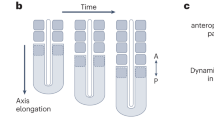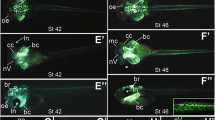Abstract
THE segmental organization of the vertebrate embryo is first apparent when somites form in a rostrocaudal progression from the paraxial mesoderm adjacent to the neural tube. Newly formed somites appear as paired epithelial spheres that become patterned to form vertebrae, ribs, skeletal muscle and dermis1–3. Paraxis is a basic helix–loop–helix transcription factor expressed in paraxial mesoderm and somites4. Here we show that in mice homozygous for a paraxis null mutation, cells from the paraxial mesoderm are unable to form epithelia and so somite formation is disrupted. In the absence of normal somites, the axial skeleton and skeletal muscle form but are improperly patterned. Unexpectedly, however, we found that formation of epithelial somites was not required for segmentation of the embryo or for the establishment of somitic cell lineages. These results demonstrate that paraxis regulates somite morphogenesis, and that the function of somites is to pattern the axial skeleton and skeletal muscles.
This is a preview of subscription content, access via your institution
Access options
Subscribe to this journal
Receive 51 print issues and online access
$199.00 per year
only $3.90 per issue
Buy this article
- Purchase on Springer Link
- Instant access to full article PDF
Prices may be subject to local taxes which are calculated during checkout
Similar content being viewed by others
References
Christ, B. & Ordahl, C. P. Anat. Embryol. 191, 381–396 (1995).
Ordahl, C. P. & LeDouarin, N. M. Development 114, 339–353 (1992).
Keynes, R. J. & Stern, C. D. Development 103, 413–429 (1988).
Burgess, R., Cserjesi, P., Ligon, K. L. & Olson, E. N. Dev. Biol. 168, 296–306 (1995).
Quertermous, E. E., Hidai, H., Blanar, M. A. & Quertermous, T. Proc. Natl Acad. Sci. USA 91, 7066–7070 (1994).
Blanar, M. A. et al. Proc. Natl Acad. Sci. USA 92, 5870–5874 (1995).
Deutsch, U., Dressler, G. R. & Gruss, P. Cell 53, 617–625 (1988).
Neubuser, A., Koseki, H. & Balling, R. Dev. Biol. 170, 701–716 (1995).
Cserjesi, P. et al. Development 121, 1099–1110 (1995).
Jostes, B., Walther, C. & Gruss, P. Mech. Dev. 33, 27–38 (1990).
Cheng, T.-C., Wallace, M., Merlie, J. P. & Olson, E. N. Science 261, 215–218 (1993).
Martin, J. F., Schwarz, J. J. & Olson, E. N. Proc. Natl Acad. Sci. USA 90, 5282–5286 (1993).
Goulding, M. et al. Genomics 17, 355–363 (1993).
Williams, B. A. & Ordahl, C. P. Development 120, 785–796 (1994).
Couly, G. F., Coltey, M. & LeDouarin, N. M. Development 117, 409–429 (1993).
Jacobson, A. G. Development 104, 209–220 (1988).
Tam, P. P. L. & Meir, S. Am. J. Anat. 164, 209 (1982).
Nieto, M. A., Gilardi-Hebenstreit, P., Charnay, P. A. & Wilkinson, D. G. Development 116, 1137–1150 (1992).
Yamaguchi, T. P., Conlon, R. A. & Rossant, J. Dev. Biol. 152, 75–88 (1992).
Muller, M., Weizsacker, E. & Campos-Ortega, J. A. Development 122, 2071–2078 (1996).
Olson, E. N. & Klein, W. H. Genes Dev. 8, 1–8 (1994).
Fan, C.-M. & Tessier-Lavigne, M. Cell 79, 1175–1186 (1994).
Li, L., Cserjesi, P. & Olson, E. N. Dev. Biol. 172, 280–292 (1995).
Wolf, C. et al. Dev. Biol. 143, 363–373 (1991).
McMahon, A. & Bradley, A. Cell 62, 1073–1085 (1990).
Martin, J. F., Bradley, A. & Olson, E. N. Genes Dev. 9, 1237–1249 (1995).
Author information
Authors and Affiliations
Rights and permissions
About this article
Cite this article
Burgess, R., Rawls, A., Brown, D. et al. Requirement of the paraxis gene for somite formation and musculoskeletal patterning. Nature 384, 570–573 (1996). https://doi.org/10.1038/384570a0
Received:
Accepted:
Issue Date:
DOI: https://doi.org/10.1038/384570a0
This article is cited by
-
Reconstituting human somitogenesis in vitro
Nature (2023)
-
Morphogenesis beyond in vivo
Nature Reviews Physics (2023)
-
Characterising open chromatin in chick embryos identifies cis-regulatory elements important for paraxial mesoderm formation and axis extension
Nature Communications (2021)
-
Recapitulating the human segmentation clock with pluripotent stem cells
Nature (2020)
-
Understanding paraxial mesoderm development and sclerotome specification for skeletal repair
Experimental & Molecular Medicine (2020)
Comments
By submitting a comment you agree to abide by our Terms and Community Guidelines. If you find something abusive or that does not comply with our terms or guidelines please flag it as inappropriate.



